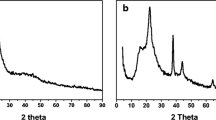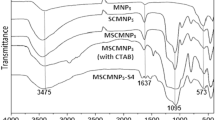Abstract
Green synthesis of nanomaterials has received increasing attention as an eco-friendly technology in materials science. Here, we have used two types of extractions from green tea leaf (i.e., total extraction and tannin extraction) as reducing agents for a rapid, simple and one-step synthesis method of mesoporous silica nanoparticles/iron oxide nanocomposite based on deposition of iron oxide onto mesoporous silica nanoparticles. Mesoporous silica nanoparticles/iron oxide nanocomposite were characterized by X-ray diffraction, Fourier transform infrared spectroscopy, scanning electron microscopy, energy-dispersive X-ray, vibrating sample magnetometer, N2 adsorption and high-resolution transmission electron microscopy. Mesoporous silica nanoparticles/iron oxide nanocomposite was used as a solid adsorbent for removal of lindane pesticide from aqueous solutions. The developed system possesses the advantages of silica as core that include large surface area and advantages of iron oxide (shell) that include the capability to interact with chlorinated compounds and ability to release by using external magnetic field. UV-Vis technique was used as a simple and easy method for monitoring the removal of lindane. Effects of pH and temperature on the removal efficiency of the developed mesoporous silica nanoparticles/iron oxide nanocomposite toward lindane pesticide were also investigated. Fourier transform infrared spectroscopy, high-performance liquid chromatography and gas chromatography techniques were used to confirm the high ability of mesoporous silica nanoparticles/iron oxide nanocomposite for sensing and the capture of lindane molecules with high sorption capacity (about 99%) that could develop a new eco-friendly strategy for detection and removal of pesticide and as a promising material for water treatment.












Similar content being viewed by others
References
Akhtar N, El-Safty SA, Khairy M, El-Said WA (2015) Fabrication of a highly selective nonenzymatic amperometric sensor for hydrogen peroxide based on nickel foam/cytochrome c modified electrode. Sens Actuators B Chem 207:158–166
Bavcon M, Trebse P, Zupancic-Kralj L (2003) Investigations of the determination and transformations of diazinon and malathion under environmental conditions using gas chromatography coupled with a flame ionisation detector. Chemosphere 50:595–601
Bhattacharya D, Rajinder G (2005) Nanotechnology and potential of microorganisms. Crit Rev Biotechnol 25:199–204
Cai W, Wan J (2007) Facile synthesis of superparamagnetic magnetite nanoparticles in liquid polyols. J Colloid Interface Sci 305:366–370
Cataldo F, Ursini O, Angelini G (2013) A green synthesis of colloidal silver nanoparticles and their reaction with ozone. Eur Chem Bull 2:700–705
Chang YC, Kikuchi S, Kawauchi N, Sato T, Takamizawa K (2008) Complete dechlorination of tetrachloroethylene by use of an anaerobic clostridium bifermentans dph-1 and zero-valent iron. Environ Technol 29:381–391
Chen Y, Wang D, Zhu X, Zheng X, Feng L (2012) Long-term Effects of copper nanoparticles on wastewater biological nutrient removal and N2O generation in the activated sludge process. Environ Sci Technol 46:12452–12458
Dang F, Enomoto N, Hpjo J, Enpuku K (2009) Sonochemical synthesis of monodispersed magnetite nanoparticles by using an ethanol–water mixed solvent. Ultrason Sonochem 16:649–654
El-Ghandoor H, Zidan HM, Khalil MMH, Ismail MIM (2012) Synthesis and some physical properties of magnetite (Fe3O4) nanoparticles. Int J Electrochem Sci 7:5734–5745
El-Said WA, Yea C-H, Jung M, Kim H-C, Choi JW (2010) Analysis of effect of nanoporous alumina substrate coated with polypyrrole nanowire on cell morphology based on AFM topography. Ultramicroscopy 110(6):676–681
El-Said WA, Kim T-H, Yea C-H, Kim HC, Choi JW (2011) Fabrication of gold nanoparticle modified ITO substrate to detect β-amyloid using surface-enhanced raman scattering. J Nanosci Nanotechnol 11:768–772
El-Said WA, Cho HY, Yea CH, Choi JW (2014) Synthesis of metal nanoparticles inside living human cells based on the intracellular formation process. Adv Mater 26(6):910–918
Fouad DM, Mohamed MB (2011) Studies on the photo-catalytic activity of semiconductor nanostructures and their gold core–shell on the photodegradation of malathion. Nanotechnology 22:455705–455713
Fouad DM, El-Said WA, Mohamed MB (2015) Spectroscopic characterisation of magnetic Fe3O4@Au core shell nanoparticles. Spectrochim Acta Part A Mol Biomol Spectrosc 140:392–397
Fouad DM, El-Said WA, Ali MH, El-Gahami MA (2017) Silica-gold nanocomposite for removal of organophosphorous pesticides. Plasmonics 12(3):869–875
Jain TK, Morales MA, Sahoo SK, LesliePelecky DL, Labhasetwar V (2005) Iron oxide nanoparticles for sustained delivery of anticancer agents. Mol Pharm 2(3):194–205
Jin Y, Wu M, Zhao X, (eds) (2005) Toxicity of nanomaterials to living cells. In: Technical proceedings of the 2005 NSTI nanotechnology conference and trade show
Johannsen M, Gneveckow U, Taymoorian K, Thiesen B, Waldofner N, Scholz R, Jung K, Jordan A, Wust P, Loening SA (2007) Morbidity and quality of life during thermotherapy using magnetic nanoparticles in locally recurrent prostate cancer: results of a prospective phase I trial. Int J Hyperth 23:315–323
Laurent S, Forge D, Port M, Roch A, Robic C, Elst LV, Muller RN (2008) Magnetic iron oxide nanoparticles: synthesis, stabilization, vectorization, physico-chemical characterizations and biological applications. Chem Rev 108(6):2064–2110
Lu AH, Li WC, Kiefer A, Schmidt W, Bill E, Fink G, Schuth F (2004) Fabrication of magnetically separable mesostructured silica with an open pore system. J Am Chem Soc 126:8616–8617
Lukman AI, Gong B, Marjo CE, Roessner U, Harris AT (2011) Facile synthesis, stabilization, and anti-bacterial performance of discrete Ag nanoparticles using Medicago sativa seed exudates. Colloid Interface Sci 353:433–444
Maity D, Chandrasekharan P, Yang CT, Chuang KH, Shuter B, Xue JM, Ding J, Feng SS (2010) Facile synthesis of water-stable magnetite nanoparticles for clinical MRI and magnetic hyperthermia applications. Nanomedicine 5:1571–1584
Modo MMJ, Bulte JWM (2005) Molecular and cellular MR imaging. CRC Press, London
Nunes JS, de Vasconcelos CL, Cabral FAO, de Araújo JH, Pereira MR, Fonseca JLC (2006) Synthesis and characterization of poly (ethyl methacrylate-co-methacrylic acid) magnetic particles via miniemulsion polymerization. Polymer 47:7646–7652
Padil VV, Cerník M (2013) Green synthesis of copper oxide nanoparticles using gum karaya as a biotemplate and their antibacterial application. Int J Nanomed 8:889–898
Parsons JG, Peralta-Videa JR, Gardea-Torresdey JL (2007) Use of plants in biotechnology: synthesis of metal nanoparticles by inactivated plant tissues, plant extracts, and living plants. Dev Environ Sci 5:463–485
Prabowo B, Veriansyah B, Kim JD (2007) Supercritical water oxidation for the destruction of toxic organic wastewaters: a review. J Environ Sci 19:513–522
Rockenberger J, Scher EC, Alivisatos AP (1999) A new nonhydrolytic single-precursor approach to surfactant-capped nanocrystals of transition metal oxides. J Am Chem Soc 121:11595–11596
Salam HA, Rajiv P, Kamaraj M, Jagadeeswaran P, Gunalan S, Sivaraj R (2012) Plants: green route for nanoparticle synthesis. Int J Biol Sci 1:85–90
Shameli K, Ahmad MB, Zamanian A, Sangpour P, Shabanzadeh P, Abdollahi Y, Zargar M (2012) Green biosynthesis of silver nanoparticles using Curcuma longa tuber powder. Int J Nanomed 7:5603–5610
Shukla G, Kumar A, Bhanti M, Joseph PE (2006) Organochlorine pesticide contamination of ground water in the city of Hyderabad. Environ Int 32:244–247
Simagina V, Likholobov V, Bergeret G, Gimenez MT, Renouprez A (2003) Catalytic hydrodechlorination of hexachlorobenzene on carbon supported Pd-Ni bimetallic catalysts. Appl Catal B 40:293–304
Vishwakarma V, Samal SS, Manoharan N (2010) Safety and risk associated with nanoparticles-a review. J Miner Mater Charact Eng 9(05):455–459
Wang D, Chen Y (2016) Critical review of the influences of nanoparticles on biological wastewater treatment and sludge digestion. Crit Rev Biotechnol 36:816–828
Wang Y, Ma W, Chen C, Hu X, Zhao J, Yu JC (2007) Fe 3+/Fe 2+ cycling promoted by Ta 3 N 5 under visible irradiation in Fenton degradation of organic pollutants. Appl Catal B 75:256–263
Wu P, Zhu J, Xu Z (2004) Template-assisted synthesis of mesoporous magnetic nanocomposite particles. Adv Funct Mater 14:345–351
Yavuz Y, Yurumez Y, Kucuker H, Ela Y, Yuksel S (2007) Two cases of acute endosulfan toxicity. Clin Toxicol (Phila) 45:530–532
Zhang W, Shen F, Hong R (2011) Solvothermal synthesis of magnetic Fe3O4 microparticles via self-assembly of Fe3O4 nanoparticles. Particuology 9:179–186
Acknowledgements
This work was supported by Assiut University.
Author information
Authors and Affiliations
Corresponding author
Additional information
Editorial responsibility: Binbin Huang
Rights and permissions
About this article
Cite this article
El-Said, W.A., Fouad, D.M., Ali, M.H. et al. Green synthesis of magnetic mesoporous silica nanocomposite and its adsorptive performance against organochlorine pesticides. Int. J. Environ. Sci. Technol. 15, 1731–1744 (2018). https://doi.org/10.1007/s13762-017-1530-9
Received:
Revised:
Accepted:
Published:
Issue Date:
DOI: https://doi.org/10.1007/s13762-017-1530-9




